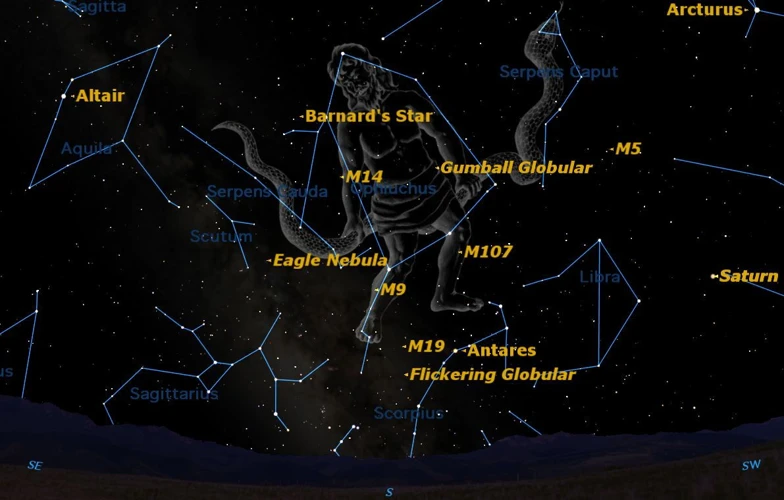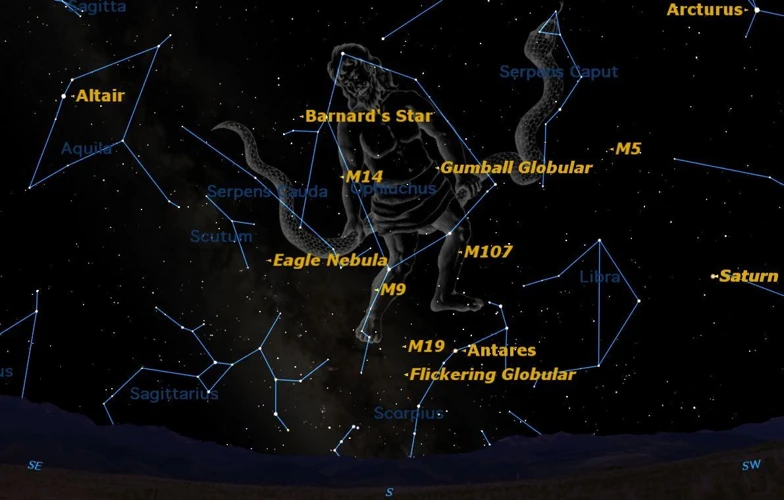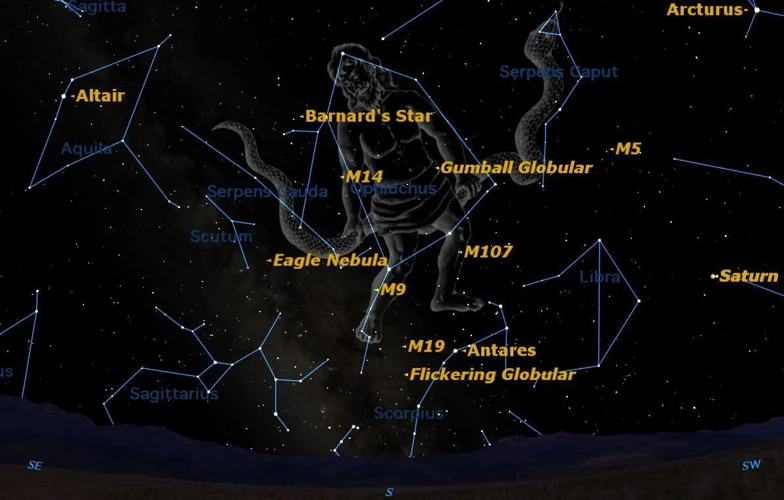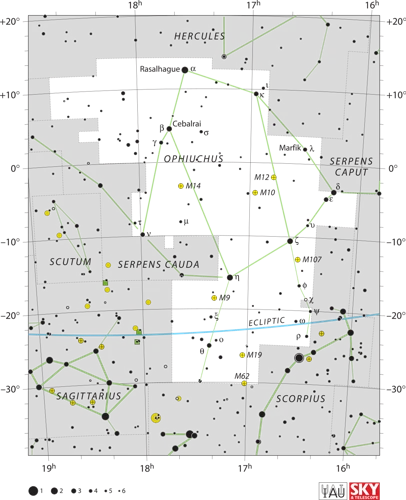The night sky has always fascinated humanity, with its dazzling array of stars forming beautiful patterns known as constellations. These celestial artworks have been studied for centuries, guiding navigators across vast oceans and inspiring tales of mythology. In this article, we will explore the different types of constellations and their unique features. From the well-known zodiac constellations that align with our astrological signs, to the enchanting northern and southern constellations that grace the skies of their respective hemispheres, and even the seasonal constellations that change with the passing of time, each type offers its own captivating stories and celestial wonders. So, let us embark on this cosmic journey and discover the many treasures that await us in the vast expanse of the night sky.
Contents
- 1. Zodiac Constellations
- 2. Northern Constellations
- 3. Southern Constellations
- 4. Seasonal Constellations
- Conclusion
-
Frequently Asked Questions
- 1. What is the significance of zodiac constellations in astrology?
- 2. How many zodiac constellations are there?
- 3. Can the zodiac constellations be seen from both hemispheres?
- 4. Are zodiac constellations the same as the astrological signs?
- 5. What are some notable stars within the zodiac constellations?
- 6. Are there any cultural and historical symbols associated with zodiac constellations?
- 7. How do zodiac constellations differ from other types of constellations?
- 8. Can I spot zodiac constellations throughout the year?
- 9. Are zodiac constellations only relevant for astrology?
- 10. How can I locate zodiac constellations in the night sky?
- References
-
Frequently Asked Questions
- 1. What is the significance of zodiac constellations?
- 2. How many zodiac constellations are there?
- 3. What are the distinguishing features of Aries constellation?
- 4. Which constellation is associated with the bull?
- 5. What are the unique characteristics of Gemini constellation?
- 6. Which constellation contains the Big Dipper?
- 7. What is special about the Cassiopeia constellation?
- 8. Which constellation is known as the dragon?
- 9. What is the significance of the Orion constellation?
- 10. What is the Southern Cross constellation also known as?
- References
- Read More
1. Zodiac Constellations

The Zodiac constellations, widely recognized for their connection to astrology, hold a special place in our celestial repertoire. Consisting of twelve distinct constellations, each representing a zodiac sign, the Zodiac constellations have been observed and studied for thousands of years. From the fiery Aries, symbolizing courage and determination, to the sturdy Taurus, embodying strength and stability, and the sociable Gemini, signifying intellect and versatility, these constellations capture the essence of the human experience. Whether you believe in the astrological interpretations or simply appreciate the beauty of these celestial artworks, the Zodiac constellations have had a significant cultural and historical impact throughout the ages. They have influenced everything from personality traits to cultural practices, leaving an indelible mark on our understanding of the cosmos. So, take a moment to marvel at the cosmic dance of the Zodiac constellations and explore the fascinating connection between the stars and our lives. Cultural and historical significance surrounding these constellations further adds to their allure, offering profound insights into our shared human experience.
1.1 Aries
Aries, the first zodiac constellation, heralds the arrival of spring in the northern hemisphere. Represented by a ram, Aries is associated with courage, leadership, and determination. This constellation is home to several notable celestial objects, including the spiral galaxy NGC 772, which can be observed with a telescope. Additionally, within Aries lies the star cluster known as the Hyades, consisting of a group of stars located approximately 150 light-years away. The brightest star in Aries is Hamal, which shines with a reddish hue and marks the head of the celestial ram. If you’re interested in exploring more about the zodiac constellations, venture further into the mysterious world of the Gemini constellation, where you can encounter the celestial twins Castor and Pollux. The ancient alignments of constellations like Aries also hold significant astronomical and cultural importance, giving us insights into how ancient civilizations interpreted the night sky. So, keep your eyes fixed on the heavens and unravel the wonders of Aries, a constellation intertwined with the essence of new beginnings and daring adventures.
1.2 Taurus
Taurus, the second sign of the zodiac, is a constellation rich in mythology and celestial beauty. Represented by the mighty bull, Taurus embodies qualities of determination, strength, and stability. At the heart of the Taurus constellation lies the famous Taurus Cluster, also known as the Pleiades. This cluster consists of seven bright stars, which have captivated astronomers and sky-watchers for millennia. The Pleiades, with its stunning blue stars, is often referred to as the Seven Sisters and has deep cultural significance in various mythologies around the world. In Greek mythology, the Pleiades were the daughters of Atlas and Pleione, and their appearance in the sky marked the arrival of spring. These seven stars are easily visible to the naked eye and have been a celestial highlight for stargazers throughout history. Another prominent feature of Taurus is the red giant star called Aldebaran. This bright and fiery star marks the eye of the bull and adds to the constellation’s allure. Associated with wealth and success, Aldebaran has been observed and revered by different civilizations over the centuries. Taurus is also home to other fascinating celestial objects, such as the Taurus Molecular Cloud, a vast cloud of gas and dust where new stars are born. This nebula is an active region of star formation, presenting a visually stunning spectacle when observed through telescopes. Taurus, with its prominent visual features and captivating mythology, is a truly remarkable constellation that continues to inspire and awe those who gaze upon its celestial wonders.
1.3 Gemini
Gemini is one of the twelve zodiac constellations, symbolizing the celestial twins. Located in the northern hemisphere, it is one of the most well-known and recognizable constellations in the night sky. The Gemini constellation is associated with the Greek myth of Castor and Pollux, who were said to be twin brothers and skilled horsemen. Its prominent stars, Castor and Pollux, represent the heads of the twins, and they are easily identifiable. Castor is a binary star system, consisting of two stars orbiting around a common center of mass, while Pollux is a giant orange star. Apart from these main stars, Gemini also contains other notable stars such as Alhena, Mebsuta, and Tejat. The constellation is also home to the famous Celestial Twins, which are two open star clusters named M35 and NGC 2158. These clusters contain numerous young stars and are a captivating sight through a telescope. Gemini is best seen during winter evenings in the Northern Hemisphere and is easily visible to the naked eye. In addition to its mythological and astronomical significance, Gemini is associated with qualities such as communication, adaptability, and intellect, due to its association with the twins. Whether you are an avid stargazer, astrology enthusiast, or simply appreciative of the beauty of the night sky, observing Gemini is an experience that will surely leave you in awe of the wonders above.
2. Northern Constellations

Gazing upon the night sky in the northern hemisphere reveals a host of captivating constellations. Among these, the Ursa Major shines brightly, known for its iconic Big Dipper shape that has guided countless navigators across the ages. A neighboring constellation, Cassiopeia, with its distinct ‘W’ or ‘M’ formation, tells the mythical tale of the beautiful yet vain queen of Aethiopia. And let us not forget about Draco, the dragon constellation that winds its way through the celestial sphere, captivating observers with its winding form. These northern constellations hold a special place in the hearts of stargazers, not only for their beauty but also for their rich cultural and historical significance. So, lean back, look up, and immerse yourself in the enchanting wonders of the northern constellations, connecting you with the mysteries of the universe.
2.1 Ursa Major
Ursa Major, also known as the Great Bear, is one of the most recognizable and prominent constellations in the northern hemisphere. It is characterized by its distinct shape resembling a large bear, with the stars forming a pattern that is often referred to as the “Big Dipper.” Ursa Major is located adjacent to the North Star, making it an easily identifiable reference point for navigating the night sky.
The seven bright stars that make up the Big Dipper are named after their positions and are often used as a guide for finding other celestial objects. The two stars at the end of the bowl of the Big Dipper, called Dubhe and Merak, point towards the North Star, which in turn helps locate other constellations and stars.
Ursa Major has rich mythological significance across various cultures. In Greek mythology, it is associated with the story of Callisto, a nymph who caught the eye of Zeus and was transformed into a bear to protect her from the wrath of Zeus’ wife, Hera. Ursa Major is said to represent Callisto in bear form, while her son Arcas is symbolized by the adjacent constellation Ursa Minor, the Little Bear.
Aside from its mythological and navigational importance, Ursa Major contains several interesting astronomical objects. One notable feature is the Messier 81 galaxy, also known as Bode’s Galaxy, which is located within the constellation. This spiral galaxy is approximately 12 million light-years away from Earth and is home to billions of stars.
Ursa Major is a constellation that has captivated observers for centuries with its distinctive shape, navigational significance, and intriguing astronomical features. Whether gazing up at the night sky or exploring the wonders of the universe, Ursa Major continues to be a celestial masterpiece that leaves us in awe of the vastness and beauty of the cosmos. Astronomical alignments within this constellation further deepen our understanding of the universe and our place within it.
2.2 Cassiopeia
Cassiopeia, one of the most recognizable northern constellations, is a prominent feature in the night sky. This constellation is named after the queen of Aethiopia in Greek mythology, famed for her beauty. Cassiopeia can be easily identified by its distinctive shape, resembling a “W” or an “M,” depending on its position in the sky. It is often referred to as the “Celestial Queen.”
Cassiopeia is located in the region of the Milky Way and contains a plethora of interesting celestial objects. One notable feature within Cassiopeia is the famous “Open Cluster M52.” This cluster is composed of a group of stars that formed from the same molecular cloud. It has an apparent magnitude of 7.3, making it visible with binoculars or a small telescope.
Another intriguing object in Cassiopeia is the “Bubble Nebula” (NGC 7635). This emission nebula is shaped like a bubble, hence its name. It was formed by the stellar wind from a massive, young, hot star at its center. The Bubble Nebula is a stunning sight to behold, especially through a telescope capable of capturing the intricate details of its structure.
A star of particular interest within the Cassiopeia constellation is Eta Cassiopeiae, also known as Achird. It is a binary star system consisting of two stars orbiting each other. The contrasting colors of the two stars—a yellow star and a blue star—make them visually striking when observed.
Cassiopeia is also home to several other star clusters, nebulae, and double stars that are worth exploring. Its prominent position in the northern sky during fall and winter months makes it a popular target for stargazers and astrophotographers alike. So, next time you find yourself marveling at the night sky, try to locate Cassiopeia with its distinct “W” shape and explore the wonders it holds.
2.3 Draco
Draco, the majestic dragon constellation, is a prominent feature in the northern hemisphere’s night sky. It is one of the largest constellations, spanning over 1,000 square degrees. Named after the Latin word for dragon, Draco is rich in mythology and lore. According to ancient Greek mythology, Draco represents the dragon slain by the hero Hercules as part of his Twelve Labors. The constellation is easily recognizable by its curving shape, resembling a winding serpent or dragon. It is often depicted coiling around the Little Dipper, particularly its handle, with its head extending towards the celestial north pole. One of the most distinct features of Draco is its alignment with the North Star, also known as Polaris, making it a useful guide for navigators and amateur stargazers alike. In addition to its historical and navigational significance, Draco hosts several notable celestial objects. One of these is the Cat’s Eye Nebula, a planetary nebula located within Draco, known for its vibrant colors and intricate structure. Another intriguing feature within the constellation is the binary star system known as Eltanin, which consists of two stars orbiting around a common center. Draco offers a captivating blend of mythology, navigational importance, and celestial wonders, making it a celestial delight for observers and a key player in the cosmic tapestry.
3. Southern Constellations

The southern sky is adorned with a dazzling array of constellations that captivate observers from the southern hemisphere. These southern constellations offer a unique glimpse into the celestial wonders of the southern skies. Among them, the mighty Orion takes center stage, with its distinctive belt and stunning nebulae that grace the winter nights. Another prominent constellation is Centaurus, which showcases the dazzling sight of the bright star Alpha Centauri, our neighboring star system. Not to be forgotten is the Crux, or the Southern Cross, a symbol of the southern hemisphere with its distinct shape that has guided travelers for centuries. As you gaze upon these southern constellations, you are transported to a world of celestial beauty and wonder, where new stories and myths unfold against the backdrop of the vast, star-studded sky.
3.1 Orion
Orion, one of the most recognizable constellations in the night sky, holds a special place in ancient mythology and modern astronomy alike. This prominent constellation is named after Orion, a mighty hunter from Greek mythology. It is characterized by its distinctive pattern of three bright stars forming Orion’s Belt and four surrounding stars representing his shoulders and feet. Orion’s Belt is comprised of the stars Alnitak, Alnilam, and Mintaka, which appear aligned in a straight line. Surrounding these stars, we find other notable features like Betelgeuse, a red supergiant and one of the largest known stars, and Rigel, a blue supergiant that marks Orion’s foot.
This constellation has captivated humans for centuries, and its significance spans across cultures. In Greek mythology, Orion was a legendary hunter who was eventually placed among the stars by the gods. In some traditions, he is depicted holding a club and shield, while in others, he is portrayed with a bow and arrow. The mythological tales associated with Orion add an element of mystique to this celestial wonder.
In addition to its cultural significance, the constellation Orion is a prominent feature in astronomy. Its location in the celestial equator makes it visible from many parts of the world. Astronomers have made numerous discoveries within Orion, including star clusters, nebulae, and even exoplanets. The Orion Nebula, also known as Messier 42, is one of the most studied and photographed objects in the night sky. It is a stellar nursery where new stars are being formed, offering astronomers a glimpse into the process of stellar birth and evolution.
Whether you’re an avid stargazer or simply appreciate the beauty of the night sky, Orion is a constellation that commands attention. Its striking appearance and rich mythology make it a favorite among both amateur and professional astronomers. So, the next time you gaze up at the stars, don’t forget to look for Orion and let its celestial wonders ignite your sense of wonder and curiosity.
3.2 Centaurus
Centaurus is a prominent constellation located in the southern sky. It is one of the largest constellations and boasts several intriguing features. Here are some fascinating aspects of Centaurus:
1. Alpha Centauri: One of the most notable stars in the night sky, Alpha Centauri is a triple star system consisting of three stars – Alpha Centauri A, Alpha Centauri B, and Proxima Centauri. Proxima Centauri, the closest star to our solar system, is a red dwarf and is just over four light-years away.
2. Centaurus A: Also known as NGC 5128, Centaurus A is a peculiar galaxy located within the Centaurus constellation. It is a powerful radio source and exhibits a unique structure that combines properties of both elliptical and spiral galaxies. Its distinctive dust lane across the galaxy’s center is a hallmark feature visible even with small telescopes.
3. Omega Centauri: This globular cluster is a true celestial gem within Centaurus. It is one of the brightest and largest globular clusters, containing millions of stars densely packed together. Omega Centauri is often considered one of the most impressive sights in the night sky.
4. Multiple Star Systems: Centaurus is home to several other multiple star systems besides Alpha Centauri. Epsilon Centauri, for example, is a quadruple star system with four stars orbiting one another. This cluster of stars can be seen with the naked eye, appearing as a single point of light.
5. The Centaurus A Supercluster: Centaurus is also a host to the Centaurus A Supercluster, an enormous collection of galaxies spanning hundreds of millions of light-years. This supercluster contains several galaxy clusters, making it a fascinating area of study for astronomers.
Centaurus is a constellation that offers a wide range of celestial wonders, from binary star systems and peculiar galaxies to stunning globular clusters and vast superclusters. Exploring these captivating features further ignites our curiosity about the vastness of the universe.
3.3 Crux
Crux, also known as the Southern Cross, is a prominent constellation visible in the southern hemisphere. It is one of the smallest constellations but holds significant cultural and historical importance. Here are some key features of Crux:
1. Shape: Crux is characterized by its distinctive shape, resembling a cross. It consists of four stars that form the cross’s arms, with the brightest star, Acrux, marking the foot of the cross.
2. Navigation: Due to its proximity to the south celestial pole, Crux has been widely used as a navigational tool. Sailors in the southern hemisphere have relied on Crux to determine their latitude and navigate across vast oceans.
3. Ancient Mythology: Crux has rich mythology associated with it. In many South American cultures, the constellation represents the Southern Cross, a symbol of navigation and guidance. It has been linked to various myths and legends, including stories of gods and heroes.
4. Stellar Features: The stars within Crux are not only visually striking but also have fascinating properties. Acrux, the brightest star, is a binary star system, composed of two hot blue stars orbiting each other. The other three stars, Beta Crucis, Gamma Crucis, and Delta Crucis, also contribute to the beauty of the constellation.
5. Visibility: Crux is primarily visible in the southern hemisphere and cannot be seen from latitudes above 25 degrees north. It reaches its highest point in the sky during the Southern Hemisphere’s summer months, making it an iconic sight for stargazers in that region.
So, if you find yourself in the southern hemisphere, be sure to gaze upon the mesmerizing Crux constellation and appreciate its cultural significance, celestial beauty, and navigational importance.
4. Seasonal Constellations

As the seasons change, so too do the constellations that grace the night sky. Seasonal constellations bring a sense of excitement and anticipation, as they appear only during specific times of the year. Among these celestial wonders, we find the majestic Canis Major, with its bright star Sirius, also known as the Dog Star, shining brilliantly in the winter sky. Hydra, the largest of all constellations, stretches across the southern hemisphere during the summer months, its sprawling form a testament to the vastness of the cosmos. And let us not forget Pegasus, the winged horse of Greek mythology, which takes center stage during the autumn months. Each seasonal constellation has its own unique charm and stories to tell, reminding us of the cyclical nature of time and the ever-changing beauty of the night sky. So, as you stargaze during different seasons, let these constellations guide your imagination and fill you with wonder and awe.
4.1 Canis Major
Canis Major, meaning “Greater Dog” in Latin, is one of the most prominent constellations in the night sky. It is easily recognizable for its bright star, Sirius, which is the brightest star visible from Earth. Located in the southern celestial hemisphere, Canis Major is best seen during the winter months in the Northern Hemisphere. This majestic constellation has been celebrated throughout history and is associated with various mythologies and cultures. In Greek mythology, Canis Major is said to represent the loyal hunting dog of Orion the Hunter. The star Sirius, also known as the “Dog Star,” holds great significance and has been worshipped by different civilizations. Ancient Egyptians believed that the annual flooding of the Nile River was connected to the rising of Sirius, which marked the beginning of their new year. Canis Major is also home to other notable stars and deep-sky objects, including the open cluster M41 and the diffuse nebula NGC 2359, known as Thor’s Helmet. Whether you’re an amateur stargazer or a seasoned astronomer, exploring the wonders of Canis Major will surely leave you in awe of the vastness and beauty of the night sky.
4.2 Hydra
Hydra is a unique and fascinating constellation that holds a prominent position in the night sky. It is the largest known constellation, stretching across a vast area of space. Named after the mythical water serpent Hydra, this constellation has captivated human imagination for centuries. Hydra is best observed in the Southern Hemisphere, where it dominates the celestial landscape during the winter months. This celestial serpent is known for its distinctive shape, resembling a winding snake, with its head positioned near the Cancer constellation. Within the Hydra constellation lies a celestial wonder called the Alpha Hydrae, which is a binary star system consisting of two stars orbiting each other. This system emits a striking white light and serves as a prominent feature within the Hydra constellation. Exploring Hydra with a telescope reveals a treasure trove of other deep-sky objects, including galaxies, star clusters, and nebulae. A prominent example is the Hydra Cluster, a massive collection of galaxies located within this constellation. Additionally, Hydra hosts several celestial phenomena, such as the stellar nursery IC 1613, which is home to young, hot stars. The Hydra constellation offers stargazers a wealth of celestial wonders to explore and appreciate, making it a captivating sight for both astronomers and astrology enthusiasts alike.
4.3 Pegasus
Pegasus, the majestic winged horse of Greek mythology, is a magnificent constellation located in the northern sky. This celestial equine takes its name from the mythical character, known for its association with heroes and the power of flight. Its distinct shape can be traced through a series of stars that form the outline of a horse with outstretched wings. Pegasus is a prominent feature in the night sky during the autumn months in the Northern Hemisphere. Its most recognizable asterism is the Great Square of Pegasus, a prominent pattern of four bright stars that form a square shape.
Within the boundaries of the Pegasus constellation lies the remarkable star Epsilon Pegasi, also known as Enif. Enif holds the distinction of being one of the brightest stars in the night sky and is often described as Pegasus’ nose. It illuminates the surrounding cosmos with its radiant glow. Pegasus is also associated with the famous Andromeda galaxy, which can be seen as a faint smudge of light within the boundaries of the constellation.
The mythology surrounding Pegasus adds to its mystique and charm. According to Greek mythology, Pegasus was born from the decapitated neck of the Gorgon Medusa, a creature with snakes for hair who could turn anyone who looked at her into stone. Pegasus’ subsequent flight to Mount Olympus allowed him to become the trusted steed of the gods, serving as a symbol of inspiration and freedom.
Whether admired for its mythological connections or appreciated for its prominent place in the night sky, Pegasus continues to captivate stargazers and celestial enthusiasts alike. Its presence serves as a reminder of the timeless tales and symbolic representations that have shaped our understanding of the cosmos. Discovering the Pegasus constellation and its mythological significance can transport us to a world where the boundaries between imagination and reality blur, and the wonders of the universe come alive.
Conclusion

In conclusion, the realm of constellations is a testament to the wonders of our universe. From the Zodiac constellations, deeply intertwined with astrology and human interpretations, to the captivating northern and southern constellations that grace the skies of different hemispheres, and the seasonal constellations that mark the passing of time, each type holds its own unique allure. The Zodiac constellations have played a significant role in shaping our cultural and historical beliefs and have fascinated humanity for centuries. The northern constellations like Ursa Major, Cassiopeia, and Draco have captivated stargazers with their distinctive shapes and stories. The southern constellations, including Orion, Centaurus, and Crux, offer a celestial spectacle exclusive to those in the southern hemisphere, guiding sailors and inspiring the imagination. The seasonal constellations, such as Canis Major, Hydra, and Pegasus, add a dynamic aspect to the night sky, changing according to the time of year. Whether you find yourself gazing at the stars from a city or a remote location, these constellations remind us of the vastness and beauty that resides above. So, let us continue to explore, reflect, and marvel at the celestial wonders that await us, for in the intricate dance of these constellations, we find both a connection to our past and a glimpse into the mysteries that lie beyond.
Frequently Asked Questions

1. What is the significance of zodiac constellations in astrology?
Zodiac constellations are significant in astrology as they are believed to influence personality traits and life events based on the position of the Sun in relation to these constellations at the time of birth.
2. How many zodiac constellations are there?
There are twelve zodiac constellations, each corresponding to a specific astrological sign.
3. Can the zodiac constellations be seen from both hemispheres?
Yes, some zodiac constellations can be seen from both the northern and southern hemispheres, while others are more prominent in one hemisphere than the other.
4. Are zodiac constellations the same as the astrological signs?
While zodiac constellations and astrological signs share the same names, they are not exactly the same. The constellations are the actual star patterns, while astrological signs are the sections of the sky associated with specific dates and personality traits.
5. What are some notable stars within the zodiac constellations?
Some notable stars within the zodiac constellations include Aldebaran in Taurus, Regulus in Leo, and Antares in Scorpius.
6. Are there any cultural and historical symbols associated with zodiac constellations?
Yes, zodiac constellations have rich cultural and historical symbolism. For example, the ram symbolizes power and authority in Aries, while the twins showcase duality and communication in Gemini.
7. How do zodiac constellations differ from other types of constellations?
Zodiac constellations are specific star patterns that align with astrological signs and are commonly used in astrology, whereas other types of constellations may have different origins, mythological associations, or scientific purposes.
8. Can I spot zodiac constellations throughout the year?
Yes, zodiac constellations can be observed at different times of the year, depending on their positions in the sky. Some are more visible during specific seasons, while others are visible year-round.
9. Are zodiac constellations only relevant for astrology?
No, zodiac constellations have significance beyond astrology. They have been important navigational aids throughout history and continue to inspire awe and wonder as part of our cultural and astronomical heritage.
10. How can I locate zodiac constellations in the night sky?
You can locate zodiac constellations by using sky maps and mobile apps that help identify specific constellations based on your location and the current time. Additionally, they are often found along the ecliptic, the path the Sun appears to follow in the sky.
References
- Constellation Guide
- Constellations And Constellation Of Stars – Zodiac …
- Major Constellations | List, Types & Fact – Video & Lesson …
Frequently Asked Questions

1. What is the significance of zodiac constellations?
Zodiac constellations hold great significance in astrology as they are believed to influence a person’s personality traits and destiny based on their birth chart.
2. How many zodiac constellations are there?
There are 12 zodiac constellations, namely Aries, Taurus, Gemini, Cancer, Leo, Virgo, Libra, Scorpio, Sagittarius, Capricorn, Aquarius, and Pisces.
3. What are the distinguishing features of Aries constellation?
Aries constellation is known for its prominent star, Hamal, which represents the head of the celestial Ram and is among the brightest stars in the sky.
4. Which constellation is associated with the bull?
The constellation Taurus is associated with the bull. Its most famous star, Aldebaran, represents the eye of the bull and is one of the brightest stars in the night sky.
5. What are the unique characteristics of Gemini constellation?
Gemini constellation is represented by the twins, Castor and Pollux. It is known for its two bright stars and is visible in both the northern and southern hemispheres.
6. Which constellation contains the Big Dipper?
The Ursa Major constellation contains the Big Dipper, which is one of the most recognizable star patterns in the northern sky.
7. What is special about the Cassiopeia constellation?
Cassiopeia is a distinctive constellation in the shape of a “W” or “M” in the northern sky. It contains several prominent stars and is easily visible during certain seasons.
8. Which constellation is known as the dragon?
Draco, the dragon constellation, winds its way around the north celestial pole. It is best seen during the northern hemisphere’s summer months.
9. What is the significance of the Orion constellation?
Orion is one of the most recognizable constellations in the sky and has many bright stars, including Betelgeuse and Rigel. It is associated with the mythical hunter Orion from Greek mythology.
10. What is the Southern Cross constellation also known as?
The Southern Cross constellation is also known as Crux. It is a small but prominent constellation visible in the southern hemisphere and is used for navigation in the southern sky.







